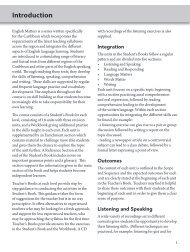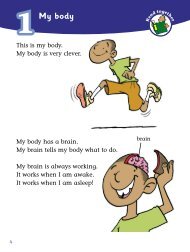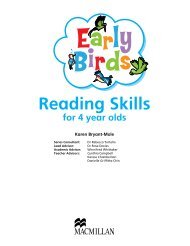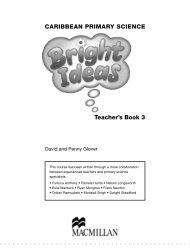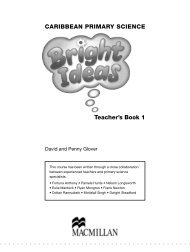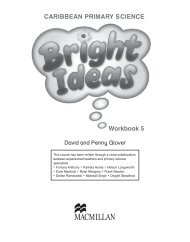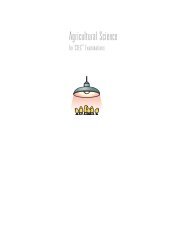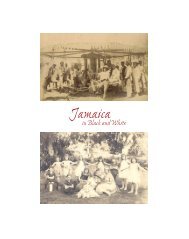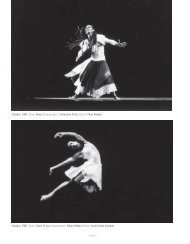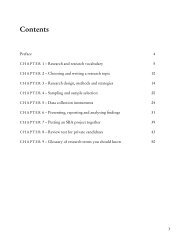Student's Book 2 - Macmillan Caribbean
Student's Book 2 - Macmillan Caribbean
Student's Book 2 - Macmillan Caribbean
You also want an ePaper? Increase the reach of your titles
YUMPU automatically turns print PDFs into web optimized ePapers that Google loves.
mathsMatters<strong>Macmillan</strong> Mathematics for the <strong>Caribbean</strong>Student’s <strong>Book</strong> 2Geoff Buckwell and Robert SolomonMMG8_00_prelims(i-viii).indd 112/30/10 10:40:58 AM
ContentsIntroductionScope and sequence1 Number bases 11.1 Binary numbers 11.2 Arithmetic in binary 41.3 Base 5 62 Operations on numbers 112.1 Decimals and fractions 122.2 Using a calculator 142.3 Order of operations (BODMAS) 172.4 Fractions and ratio 192.5 Comparing and ordering numbers 202.6 Number patterns 223 Sets 273.1 Notation for sets 273.2 Operations on sets 313.3 Word problems 354 Squares, square roots and indices 394.1 Squares 394.2 Square roots 414.3 Index notation 435 Circles 495.1 Parts of a circle 495.2 Circumference and diameter 515.3 Area of a circle 556 Areas 596.1 Units of area 596.2 Area of a triangle 616.3 Compound shapes 647 Shapes and angles 707.1 Measuring and drawing angles 707.2 Sum of angles 727.3 Equal angles 737.4 Types of triangle 777.5 Angles in a triangle 787.6 Angles in a quadrilateral 817.7 Angles in a polygon 838 Solids 908.1 Nets of solids 908.2 Units for volume and capacity 958.3 Volumes of solids 968.4 Estimating volume 99vviiiiMMG8_00_prelims(i-viii).indd 312/30/10 10:41:00 AM
IntroductionMaths Matters is a four-book course for secondary schools in the <strong>Caribbean</strong>. The first three books covergrades 7, 8 and 9, and the fourth book prepares students for the CSEC examination. The ideas areexplained clearly and in an attractive way, methods are demonstrated by fully worked examples andthere are ample exercises for practice, revision and homework. Each unit starts by stating clearly theskills that will be developed and ends with a full summary. All of the exercises are carefully gradedto cater for all abilities. Each book also provides end of year exam papers. The texts are supported byWorkbooks for those pupils who need extra support, Teacher’s Guides and material on the Internet.Each Student’s <strong>Book</strong> unit contains the following features:• Key skills you will learn in this unit – listing the learning objectives of the unit.• What you need to know – listing the preliminary knowledge required for the unit. Where relevant,revision material is provided.• Summary – what has been achieved in the unit.• Progress exercise – testing the material covered in the unit.• Homework exercises• Multiple choice questions providing practice for examination papers.The books are attractively presented in colour, and are designed to be relevant to modern daily life andthe experiences of students. They are consistent with modern computer technology, while retainingknowledge of traditional methods.The different countries of the <strong>Caribbean</strong> have different currencies, such as the Jamaican dollar (J$),the Barbados dollar (Bds$) and so on. Below is a list of the currencies, with the exchange rates withthe United States dollar (US$), correct at the time of printing.Country Currency Symbol Approximate value of 1 US$Jamaica Jamaican dollar J$ J$ 85Trinidad and Tobago Trinidad and Tobago dollar TT$ TT$ 6.3Barbados Barbados dollar Bds$ Bds$ 2Antigua, St Lucia etc. East <strong>Caribbean</strong> dollar EC$ EC$ 2.7Belize Belize dollar BZ$ BZ$ 1.95Guyana Guyana dollar GY$ GY$ 200Many people travel abroad during their lives, for work or for holidays. They meet different traditionsand institutions, and in many cases the money systems are different. These different currencies areused throughout this book, which will give students experience in dealing with money from othercountries.MMG8_00_prelims(i-viii).indd 512/30/10 10:41:02 AM
Scope and sequenceSyllabus headingSection in bookBases 2 and 5: +, −, × 1.2, 1.3Conversion from bases 2 and 5 to base 10 and vice versa 1.1, 1.3Rounding fractions 2.1Fraction as a ratio 2.4Ordering numbers 2.5Number patterns 2.6Data given in verbal form 3.1Venn diagram, three sets 3.1, 3.2, 3.3Intersecting sets 3.2Disjoint sets 3.2Subsets 3.3Number patterns 4.1, 2.6Square numbers 4.1Square roots 4.2Use of calculator 4.1, 4.2, 2.3Reasonableness of answer 2.3Circumference of circle 5.2C = πd and C = 2πr 5.2Use of appropriate units 6.1Conversion between units 6.1Area of triangle 6.2Problems with area of triangle 6.2Area of circle 5.3Units of volume 8.2Converting between units 8.2Volumes of cuboid 8.3Estimation of volume 8.4Nets of solids 8.1Angles when lines meet 7.3Sum of angles 7.2Measuring, drawing angles 7.1Translation 9.2viMMG8_00_prelims(i-viii).indd 612/30/10 10:41:03 AM
Syllabus headingSection in bookRotation 9.3Relationship between object and image 9.1, 9.2, 9.3, 9.4Similarity 9.5Congruence 9.4Types of triangle 7.4• Scope and sequenceSum of angles in triangle 7.5Sum of angles in quadrilateral 7.6Angles in a polygon 7.7Unknown angles in diagramsConstruction of circle 5.1Arc, sector, segment 5.1Collecting and representing data 10.1Frequency tables 10.4Line graphs 10.3Averages: mean, median, mode 10.4Probability 10.5Mappings of relations 11.2Tables for mappings 11.3One-to-one mappings 11.4Rule of a mapping 11.5Equations to illustrate and solve problems 12.47.2, 7.3, 7.4, 7.5, 7.6,7.7Solution of equations 12.1, 12.2, 12.3Simple literal equations 12.1, 12.2, 12.3Banking 13.1Interest 13.2Commission 13.3Taxes 13.4Utility bills 13.5Types of relation 14.1Ordered pairs 14.1Graphs of mappings 14.2Straight line graphs 14.2, 14.3Simultaneous equations 14.4viiMMG8_00_prelims(i-viii).indd 712/30/10 10:41:04 AM
Unit 1 Number basesKey skills developed in this unit▶▶Understanding the binary system and thebase 5 systemCarrying out arithmetic using binary andbase 5 numbersWhat you need to know▶ Basic arithmetic▶ Powers1.1 Binary numbersMany things can have only one of two states. For example, a lightswitch can be on or off, and a coin can land heads or tails. Similarly,computers used to be programmed with punched tape; each area ofthe tape either had a hole punched in it or it did not.There are only two binary digits, 0 and 1. So binary notation isused for things that have only two states.The base 10 or denary system uses the digits 0, 1, 2, 3, up to 9.The base 2 or binary system uses only the digits 0 and 1.In a base 10 number, each digit represents a multiple of a power of 10.So 572 means 5 hundreds + 7 tens + 2 units.In a base 2 number, each digit represents a multiple of a power of 2. So 11011 means1 sixteen + 1 eight + 0 four + 1 two + 1 unitwhich is 16 + 8 + 2 + 1 = 27The table below gives the first 16 numbers in denary and binary.Denary 1 2 3 4 5 6 7 8Binary 1 10 11 100 101 110 111 1000Denary 9 10 11 12 13 14 15 16Binary 1001 1010 1011 1100 1101 1110 1111 10000To show that a number is in binary, write either 2or twoat the end, as 11011 2or 11011 two.Exercise 1.1A (oral)1 Convert the following denary numbers to binary.a 4 b 6 c 10 d 9e 11 f 15 g 13 h 122 Convert the following binary numbers to denary.a 11 2b 101 2c 110 2 same d size1001 2TechTypee 1110 2f 1111 2g 1100 2 illustrator h CS4 1010 2<strong>Macmillan</strong> mathematics caribbean level 2 Grade 8Fig 1.1011100111000101110001110101010100110011110011100010101000111100101000101010101011000110101000011100101010011001010111110101100010101001100111010001010101010001010011101011001010010010100011010100110010100110010100111101000101101001001001100010110101010001011110101010010110100111101001101010110010101011000111001010100011001010011100101001101001001000101010001110001110101010011010011001001011010100101010010100100011101010101100001110101001001101000101111010101011011100110110100011101010100110101001100010MMG8_01(1-10).indd 112/30/10 10:41:51 AM
Unit 1Number bases •Exercise 1.1BCoins can land either heads or tails. Suppose that headsrepresents 1 and tails represents 0. Spin a coin four timesand write down the number it gives in both binary anddenary.Exercise 1.1CWith fingers and thumbs of both hands, we can count up to 10.Using binary numbers, we can count further. If a finger is down itrepresents 0, and if it is up it represents 1. The illustration on the leftshows 0011000001 2, which is 193 10.1 What number is shown on the right?2 How is 17 represented?3 What is the largest number we can represent in this way?Exercise 1.1DSix lines are chosen by chance, which are either broken or not broken. Some combinations are shownin the diagram.1 How many combinations of six lines are possible?2 How could you represent these combinations with binary numbers?aribbean level MMG8_01(1-10).indd 2 Grade 8 212/30/10 10:42:19 AM
Unit 1Converting binary to denaryTo convert a binary number to denary, multiply each digit by a power of 2 and add.Example 1Convert 1101101 2to base 10.• Number basesSolutionWrite the table below, which gives the powers of 2 in the top row, and the number in the bottom row.Powers of 2 64 32 16 8 4 2 1Binary number 1 1 0 1 1 0 1Add all the powers of 2 with a 1 below them.64 + 32 + 8 + 4 + 1 = 109So 1101101 2= 109 10Example 2Convert 110110 2to base 10.SolutionThere are 1s in the places for 32, 16, 4 and 2.32 + 16 + 4 + 2 = 54So 110110 2= 54 10Example 3Example 4Convert 25 10to base 2.Convert 39 tento base 2.SolutionSolutionDivide 25 by 2 until 0 is reached. At each stage,2 ) 39write down the remainder. At the first stage,2 ) 19 remainder 125 ÷ 2 is 12 remainder 1.2 ) 9 remainder 12 ) 252 ) 4 remainder 12 ) 12 remainder 12 ) 2 remainder 02 ) 6 remainder 02 ) 1 remainder 02 ) 3 remainder 00 remainder 12 ) 1 remainder 1Hence 39 ten= 100111 two0 remainder 1Now write down the remainders, from thebottom to the top. This is the number in base 2.So 25 10= 11001 2MMG8_01(1-10).indd 312/30/10 10:42:21 AM
Unit 1Number bases •Exercise 1.1E1 Convert the following base 2 numbers to base 10.a 11011 2b 10011 2c 11101 2d 10001 2e 101011 2f 110100 2g 100010 2h 111110 2i 101010 2j 111000 2k 100001 2l 110011 22 Convert the following base 10 numbers to base 2.a 19 b 37 c 31d 47 e 52 f 67g 73 h 76 i 84j 99 k 104 l 112m 115 n 126 o 1291.2 Arithmetic in binaryArithmetic in binary follows the same rules as arithmetic in denary.In binary, 1 2+ 1 2= 10 2. So write down 0 and carry 1 to the next column.Example 5Evaluate the following, leaving each answer in binary.(a) 11101 2+ 10111 2(b) 11010 2− 111 2(c) 1101 2× 101 2Solution(a) The addition is shown below.11101+ 101111101001 1 1 1 1As in denary arithmetic, start by adding the numbers in the units column and work to the left.▶1st (units) column: In binary, 1 + 1 = 10 (not 2). So when 1 is added to 1, write down 0 and carry1 to the next column. Write down the sum as shown.▶ 2nd column: 1 is carried. 0 + 1 + 1 = 10. Write down 0 and carry 1.▶ 3rd column: 1 is carried. 1 + 1 + 1 = 11. Write down 1 and carry 1.▶ 4th column: 1 is carried. 1 + 1 + 0 = 1. Write down 0 and carry 1.▶ 5th column: 1 is carried. 1 + 1 + 1 = 11. Write down 1 and carry 1.▶ 6th column: The only number is the carry of 1. Write down 1.So 11101 2+ 10111 2= 110100 2MMG8_01(1-10).indd 412/30/10 10:42:22 AM
Unit 1(b) In binary, 10 − 1 = 1. So when 1 is subtracted from 0, borrow 10 from the next column. Set outthe subtraction as shown.11010− 11110011• Number basesSo 11010 2− 111 2= 10011 2(c) Multiply 1101 by 100 and by 1, then add the results. To multiply by 1, write out the number. Tomultiply by 100, insert two 0s at the right of the number, then write it out.1101× 10111011101001000001So 1101 2× 101 2= 1000001 2Example 6Find x, given that x 2− 1101 2= 1000001 2.SolutionRewrite the equation as x 2= 1101 2+ 1000001 2.Now add these numbers as in example 5.So x 2= 1001110 2Exercise 1.21 Evaluate the following. All numbers are in binary. Leave your answers in binary.a 1101 + 1001 b 1010 + 1100 c 1111 + 101d 1011 + 1101 e 11001 + 101 f 10101 + 111g 1101 − 101 h 1001 − 111 i 11011 − 110j 10011 − 1100 k 11110 − 1101 l 10010 − 101m 111 × 11 n 1010 × 11 o 1100 × 101p 10011 × 111 q 11001 × 101 r 11011 × 1102 Find x 2, given that x 2− 110110 2= 1111101 2.3 Find y 2, given that y 2+ 10111 2= 100000 2.4 Find the value of x 2in each of the following.a x 2− 1111 2= 110111 2b x 2− 10111 2= 1001 2c x 2+ 10011 2= 110001 2d x 2+ 1100 2= 101001 2e x 2− 1101 2= 1000001 2f 111101 2− x 2= 1110 2MMG8_01(1-10).indd 512/30/10 10:42:23 AM
Unit 1Number bases •1.3 Base 5Numbers can be written in any base greater than 1. In much computer work, for example, numbersare written in base 16 (hexadecimal). In this section we look at numbers in base 5.A number in base 5 is written 2431 5or 2431 five. The method of conversion is the same as forconversion between binary and denary.▶▶To convert a base 5 number to denary, multiply each digit by the appropriate power of the base,then add.To convert a denary number to base 5, divide successively by the base until 0 is reached. Then writedown the remainders, from bottom to top.Example 7(a) Convert 2431 5to denary. (b) Convert 423 5to base 10.Solution(a) The powers of 5 are 1, 5, 25 and 125. Write out a table as shown, with the powers of 5 in thetop row and the digits of the base 5 number in the bottom row.125 25 5 12 4 3 1Now multiply each power of 5 by the digit and add.2431 5= 2 × 5 3 + 4 × 5 2 + 3 × 5 + 1 × 1= 2 × 125 + 4 × 25 + 3 × 5 + 1 × 1= 250 + 100 + 15 + 1 = 366So 2431 5= 366 10(b) 423 5= 4×5 2 + 2×5 + 3 = 4×25 + 2×5 + 3 = 100 + 10 + 3So 423 5= 113 10Example 8(a) Convert 492 to base 5. (b) Convert 533 to base 5.Solution(a) Divide by 5, writing down the remainders,until 0 is reached.5 ) 4925 ) 98 remainder 25 ) 19 remainder 35 ) 3 remainder 40 remainder 3Now write down the remainders, from thebottom to the top. This is the number in base 5.So 492 10= 3432 5(b)Hence5 ) 533533 10= 4113 55 ) 106 remainder 35 ) 21 remainder 15 ) 4 remainder 10 remainder 4MMG8_01(1-10).indd 612/30/10 10:42:24 AM
Unit 1▶▶▶SummaryBinary numbers express things that can be in one of two states.To convert from binary to denary, multiply each digit by a power of 2. Then add.To convert from denary to binary, divide by 2 until you reach 0. Then write down the remainders,from the bottom to the top.▶ To add in binary, remember that 1 2+ 1 2= 10 2.▶ To subtract in binary, remember that 10 2− 1 2= 1 2.▶▶To convert from base 5 to denary, multiply each digit by the corresponding power of 5, then add.To convert from denary to base 5, divide by 5 until you reach 0. Then write down the remainders,from the bottom to the top.▶ In base 5, the ‘carry’ and the ‘borrow’ are at 5.• Number basesProgress exercise 11 Convert the following binary numbers to denary.a 1011 2b 110111 2c 1011011 22 Convert the following denary numbers to binary.a 17 b 28 c 753 Evaluate the following, leaving your answers in binary.a 11101 2+ 10111 2b 101011 2+ 11011 2c 10111 2− 1100 2d 1000001 2− 110 2e 11011 2× 11 2f 10101 2× 101 24 Convert the following base 5 numbers to denary.a 41 5b 13 5c 2011 5d 224 5e 143 5f 12401 55 Convert the following denary numbers to base 5.a 558 b 121 c 4410 d 21416 Evaluate the following, leaving each answer in base 5.a 234 5+ 142 5b 2210 5+ 1222 5c 233 5+ 121 5d 440 5– 144 5e 240 5– 111 5f 1342 5– 1102 5g 42 5× 12 5h 232 5× 31 5MMG8_01(1-10).indd 912/30/10 10:42:30 AM
Unit 1Number bases •Multiple choice test 11 Convert 63 10to binary.A 111111 2B 100000 2C 100001 2D 101010 22 Convert 47 tento binary.A 11011 2B 100111 2C 11101 2D 101111 23 Convert 110011 2to base 10.A 49 B 43 C 27 D 514 Convert 10010011 2to base 10.A 76 B 75 C 147 D 4995 Evaluate 1101 2+ 1011 2, leaving your answer in binary.A 11000 B 24 C 1000 D 21126 Which of the following cannot be in base 5?A 331 B 105 C 2210 D 3017 Convert 43 5to base 10.A 23 B 43 C 101011 D 348 Convert 63 to base 5.A 63 5B 223 5C 111111 2D 2230 59 Find the product in base 5 of 11 fiveand 23 five.A 78 fiveB 253 fiveC 34 fiveD 303 five10 Subtract 104 5from 432 5and give your answer in base 5.A 328 5B 221 5C 222 5D 323 510MMG8_01(1-10).indd 1012/30/10 10:42:31 AM



